Zoos and Aquariums
Metropolitan zoos and an aquarium have led the field of zoos and aquariums in Japan with their efforts in wildlife conservation, studies and research, as well as education. Ueno Zoological Gardens opened in 1882 as Japan’s first zoo; Tama Zoological Park leverages its hilly natural environment to set up open animal enclosures with few cages and fences; Inokashira Park Zoo offers a mix of natural and cultural attractions, allowing visitors to closely observe familiar animals including those native to Japan and also to enjoy a sculpture museum; and Tokyo Sea Life Park (Kasai Rinkai Suizokuen) is designed to serve as a place for interaction between the sea and people, providing opportunities to learn about marine nature and obtain scientific knowledge on aquatic life. These four facilities collaborate with each other and have been working to offer even more attractive displays and enhanced services.
In September 2011, the TMG released the Master Plan for Metropolitan Zoos, which sets the vision for the metropolitan zoos and aquarium and outlines measures to achieve it. Based on the master plan, the Bureau is reviewing its “zoo stock plan (a breeding plan for rare species at the zoos and aquarium)” to contribute to the conservation of wildlife, and implementing improvements according to the location and nature of each facility, so that the zoos and aquarium will remain up to date and attractive to visitors and convey to future generations the importance of humans and animals living together.
Tokyo Parks Navi, a smartphone app for visitors to metropolitan parks, was launched in fiscal 2016, and the service is now offered at Ueno Zoological Gardens and Tokyo Sea Life Park. In addition to providing information on the zoo and aquarium, the app, which supports four languages, also helps visitors enjoy learning about animals and aquatic life through quizzes and a “stamp rally.”
In September 2011, the TMG released the Master Plan for Metropolitan Zoos, which sets the vision for the metropolitan zoos and aquarium and outlines measures to achieve it. Based on the master plan, the Bureau is reviewing its “zoo stock plan (a breeding plan for rare species at the zoos and aquarium)” to contribute to the conservation of wildlife, and implementing improvements according to the location and nature of each facility, so that the zoos and aquarium will remain up to date and attractive to visitors and convey to future generations the importance of humans and animals living together.
Tokyo Parks Navi, a smartphone app for visitors to metropolitan parks, was launched in fiscal 2016, and the service is now offered at Ueno Zoological Gardens and Tokyo Sea Life Park. In addition to providing information on the zoo and aquarium, the app, which supports four languages, also helps visitors enjoy learning about animals and aquatic life through quizzes and a “stamp rally.”
Ueno Zoological Gardens
The Japanese word dobutsu-en, meaning zoo, first appeared in a book published in 1866—“Seiyo Jijo (Conditions in the West)” by Yukichi Fukuzawa.The first dobutsu-en in Japan—what is now Ueno Zoological Gardens—was established as part of a museum in 1882, when the museum opened in Ueno Park.
Since then, Ueno Zoological Gardens has played various roles. In 1949, the zoo welcomed an Asiatic elephant named Indira. The gift from the Indian government greatly encouraged children in post-war Japan. In 1972, giant pandas came to the zoo, commemorating the resumption of diplomatic relations between Japan and China. They were the first pandas to come to Japan. As such, the zoo has contributed to deepening international relations. Today, it is increasingly important for the zoo to build system for international cooperation. Ueno Zoological Gardens’ efforts for the conservation and breeding of rare foreign species of wildlife include transferring animals to and from overseas facilities and exchanging information with them on rearing techniques. Such efforts have made the zoo a place where people can encounter animals from around the world, including giant pandas, western lowland gorillas, and aye-ayes.
A giant panda born in June 2017 is the first giant panda baby to be raised at Ueno Zoological Gardens in 29 years since Yu Yu, born in 1988. The zoo solicited suggestions for the name of the newborn, and from among more than 320,000 entries from the public, “Xiang Xiang” was chosen as the cub’s name. Xiang Xiang has been exhibited since December 2017. In October that year, a western lowland gorilla baby was born. The young gorilla continues to grow and is doing well, living in a troop.
Ueno Zoological Gardens’ Children’s Zoo was renovated and reopened as Children’s Zoo STEP in July 2017. This zone offers various age-appropriate exhibits and hands-on programs.
Since then, Ueno Zoological Gardens has played various roles. In 1949, the zoo welcomed an Asiatic elephant named Indira. The gift from the Indian government greatly encouraged children in post-war Japan. In 1972, giant pandas came to the zoo, commemorating the resumption of diplomatic relations between Japan and China. They were the first pandas to come to Japan. As such, the zoo has contributed to deepening international relations. Today, it is increasingly important for the zoo to build system for international cooperation. Ueno Zoological Gardens’ efforts for the conservation and breeding of rare foreign species of wildlife include transferring animals to and from overseas facilities and exchanging information with them on rearing techniques. Such efforts have made the zoo a place where people can encounter animals from around the world, including giant pandas, western lowland gorillas, and aye-ayes.
A giant panda born in June 2017 is the first giant panda baby to be raised at Ueno Zoological Gardens in 29 years since Yu Yu, born in 1988. The zoo solicited suggestions for the name of the newborn, and from among more than 320,000 entries from the public, “Xiang Xiang” was chosen as the cub’s name. Xiang Xiang has been exhibited since December 2017. In October that year, a western lowland gorilla baby was born. The young gorilla continues to grow and is doing well, living in a troop.
Ueno Zoological Gardens’ Children’s Zoo was renovated and reopened as Children’s Zoo STEP in July 2017. This zone offers various age-appropriate exhibits and hands-on programs.
-
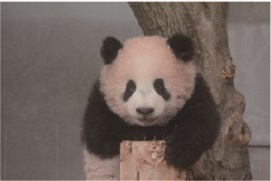 Giant panda
Giant panda -
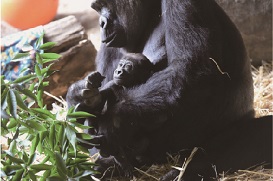 Mother western lowland gorilla and her baby
Mother western lowland gorilla and her baby
Tama Zoological Park
Tama Zoological Park, which was opened in 1958, takes advantage of its hilly natural setting in the Tama area to offer dynamic exhibitions and breed wild animals. Its exhibitions that allow animals to engage in their natural behaviors in the wild include the world’s first safari park style exhibit Lion Bus (service suspended since April 1, 2016, due to renovations), the Skywalk tightrope facility for orangutans, and the “Asian Plains” zone, where gray wolves and Przewalski’s horses live in groups. The zoo is working to make its exhibitions even more attractive to impress and excite visitors.
In 2006, the Wildlife Conservation Center was established at Tama Zoological Park. As a leader among similar facilities in Japan, the center has been contributing to wildlife conservation through such efforts as employing biotechnology to enhance research capabilities. For example, the center shelters and breeds Japanese crested ibises in cooperation with the national government and other parties. The breeding program has produced successful results, and, since 2008, ibises born at Tama Zoological Park have been soaring in the skies of Sado, Niigata prefecture where they were released into the wild.
In 2017, a number of rare offspring were born at the zoo, including a snow leopard, cheetahs, and a Malayan tapir. Currently, the Bureau is upgrading facilities at the zoo, constructing a new Asiatic elephant habitat and making the bus station for the Lion Bus service barrier-free.
In 2006, the Wildlife Conservation Center was established at Tama Zoological Park. As a leader among similar facilities in Japan, the center has been contributing to wildlife conservation through such efforts as employing biotechnology to enhance research capabilities. For example, the center shelters and breeds Japanese crested ibises in cooperation with the national government and other parties. The breeding program has produced successful results, and, since 2008, ibises born at Tama Zoological Park have been soaring in the skies of Sado, Niigata prefecture where they were released into the wild.
In 2017, a number of rare offspring were born at the zoo, including a snow leopard, cheetahs, and a Malayan tapir. Currently, the Bureau is upgrading facilities at the zoo, constructing a new Asiatic elephant habitat and making the bus station for the Lion Bus service barrier-free.
-
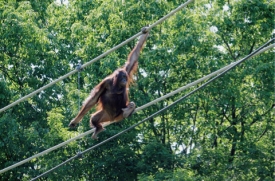 Orangutan on the Skywalk tightrope
Orangutan on the Skywalk tightrope -
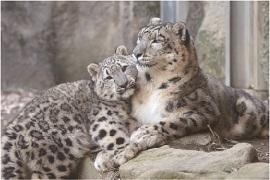 Mother snow leopard and her son
Mother snow leopard and her son
Tokyo Sea Life Park (Kasai Rinkai Suizokuen)
In 1989, an aquarium located within Ueno Zoological Gardens was relocated and expanded to become Tokyo Sea Life Park. Through its exhibitions and extensive educational and research activities, the aquarium has been playing a leading role among similar facilities in this country. Its exhibitions include the world’s first exhibit housing a school of tuna, exhibits of creatures that live in the expanse of sea off of Tokyo from Tokyo Bay to the Ogasawara Islands, one of the largest penguin exhibits in Japan, and exhibits of various aquatic species from around the world. By leveraging the high level of expertise it has developed in raising aquatic life, Tokyo Sea Life Park also exhibits other species that cannot be seen in
other aquariums in Japan, or the world.
As part of its efforts to bring its resources to citizens for educational purposes, Tokyo Sea Life Park introduced a mobile aquarium program in fiscal 2015. The mobile aquarium mainly visits hospitals and welfare facilities to convey the attractions of marine ecosystems and aquatic life to those unable to easily come to Tokyo Sea Life Park.
other aquariums in Japan, or the world.
As part of its efforts to bring its resources to citizens for educational purposes, Tokyo Sea Life Park introduced a mobile aquarium program in fiscal 2015. The mobile aquarium mainly visits hospitals and welfare facilities to convey the attractions of marine ecosystems and aquatic life to those unable to easily come to Tokyo Sea Life Park.
-
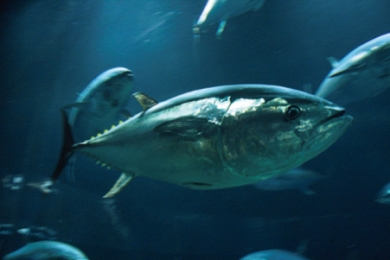 Bluefin tuna
Bluefin tuna -
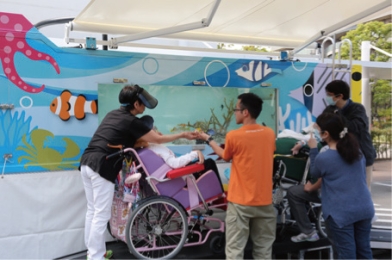 Mobile aquarium
Mobile aquarium
Inokashira Park Zoo
Opened in 1942, Inokashira Park Zoo is located in the serene setting of Inokashira Park, which is filled with lush greenery and nestled in the Tokyo suburb of Musashino. Exhibits mainly feature familiar animals native to Japan, such as Japanese squirrels, as well as opportunities for hands-on learning.The zoo is frequented by families with children, and is popular as a zoo that can be casually enjoyed anytime. The “Ikimono Hiroba (Creature Field),” which opened in 2011, offers an environment conducive to observation through the creation of an inviting space for familiar living things, including preparations such as planting trees attractive to butterflies.
Inokashira Park Zoo is actively engaged in the conservation of animals native to Japan. For example, with respect to the Tsushima leopard cat, the zoo collaborates with Nagasaki Prefecture’s Tsushima Island, the habitat of the endangered species, working not only keep and breed the cat, but also to conduct educational programs that teach the importance of conservation activities in a fun way, including holding the Yamaneko (Tsushima leopard cat) Festival, which gathers relevant organizations. The zoo's Aquatic Life House, which exhibits freshwater animals of Japan, is involved in breeding and conservation activities in cooperation with other metropolitan zoos and an aquarium. Freshwater animals such as some species of medaka (Japanese killifish) and akaharaimori (Japanese fire belly newts), while familiar to most people, are actually in danger of extinction.
In May 2016, Japan’s oldest Asiatic elephant, Hanako, who lived at the zoo, passed away at the age of 69. Many visited the zoo to pay their respects and lay flowers in her memory. To create new attractions, the zoo is currently advancing plans to repair,renovate and rebuild aging facilities.
Inokashira Park Zoo is actively engaged in the conservation of animals native to Japan. For example, with respect to the Tsushima leopard cat, the zoo collaborates with Nagasaki Prefecture’s Tsushima Island, the habitat of the endangered species, working not only keep and breed the cat, but also to conduct educational programs that teach the importance of conservation activities in a fun way, including holding the Yamaneko (Tsushima leopard cat) Festival, which gathers relevant organizations. The zoo's Aquatic Life House, which exhibits freshwater animals of Japan, is involved in breeding and conservation activities in cooperation with other metropolitan zoos and an aquarium. Freshwater animals such as some species of medaka (Japanese killifish) and akaharaimori (Japanese fire belly newts), while familiar to most people, are actually in danger of extinction.
In May 2016, Japan’s oldest Asiatic elephant, Hanako, who lived at the zoo, passed away at the age of 69. Many visited the zoo to pay their respects and lay flowers in her memory. To create new attractions, the zoo is currently advancing plans to repair,renovate and rebuild aging facilities.
-
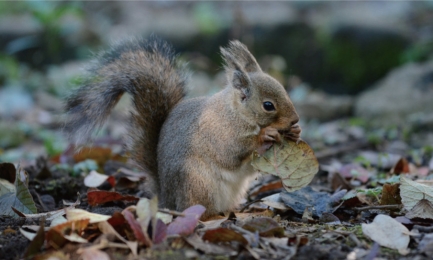 Japanese squirrel
Japanese squirrel -
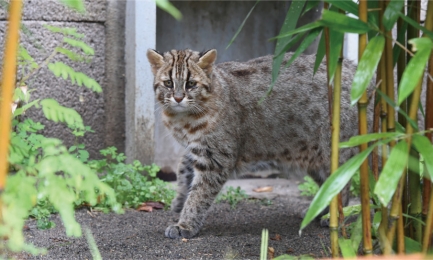 Tsushima leopard cat
Tsushima leopard cat




